How to Choose a Snowboard Binding
The Ultimate Guide to Snowboard Bindings: Choosing the Right Setup for Your Ride
Snowboard bindings are the crucial link between you and your board, directly affecting your control, comfort, and overall riding experience. Choosing the right bindings depends on your ability level, riding style, and preferred terrain. Plus, with ongoing advancements in snowboard technology, there are more options than ever before.
If you're shopping in-store, always bring your boots with you to ensure a proper fit. Now, let’s break it down step by step!
Step 1: Flex Rating – Match Your Bindings to Your Ability
The flex rating of your bindings plays a big role in how they feel and respond underfoot. Softer bindings are more forgiving and easier to maneuver, making them great for beginners, while stiffer bindings provide enhanced response for advanced riders tackling steep terrain and high speeds.
Flex Ratings:
- 1 – 2 (Soft): Ideal for beginners or freestyle riders who want a forgiving, playful feel.
- 3 – 5 (Medium): A versatile choice for all-mountain riders balancing flexibility and support.
- 6 – 8 (Stiff): Provides more control for aggressive riding and carving at higher speeds.
- 9 – 10 (Very Stiff): Best suited for expert freeriders who demand maximum responsiveness.
Step 2: Choosing Bindings Based on Terrain
Once you’ve got the basics down, you’ll likely start riding a specific type of terrain more often. Bindings are designed with different features to enhance performance for different styles of riding.
Park/Freestyle:
If you love hitting jumps, rails, and boxes in the terrain park, softer bindings (1-4 flex rating) are the way to go. They offer:
- More cushioning for impact absorption when landing tricks.
- Increased tweakability for grabs and presses.
- A more forgiving feel, making it easier to recover from sketchy landings.
All-Mountain:
For riders who like to explore all parts of the mountain, a medium-flex binding (3-6 flex rating) is the best option. These bindings provide:
- A balance of support and flexibility, making them adaptable for different conditions.
- Adjustable forward lean, allowing you to tweak your stance for carving or freestyle riding.
- Good shock absorption, ideal for handling jumps, variable snow, and fast groomer runs.
Freeride/Big Mountain:
If you’re chasing deep powder and tackling steep, challenging terrain, stiff bindings (6-10 flex rating) offer the best performance. These bindings provide:
- Maximum responsiveness, allowing for quick and precise control.
- Stronger highbacks, ensuring solid support for aggressive turns and high-speed descents.
- Reliable forward-lean adjustment, fine-tuning your stance for steep runs.
Step 3: Mounting Systems – What Works with Your Board?
Snowboard mounting systems have evolved, and compatibility is more important than ever. Here’s what you need to know:
4-Hole System (4x2 or 4x4):
- The most common system used across multiple brands.
- Compatible with nearly all snowboards except Burton’s channel system.
- Provides a stable and secure setup with consistent performance.
The Channel System (Burton):
- Found exclusively on Burton boards.
- Offers infinite stance adjustability, letting you fine-tune your position.
- Works best with EST bindings for improved board flex and feel.
EST Bindings (Burton):
- Only compatible with Burton’s Channel System.
- Feature a hassle-free mounting system with two screws.
- Reduce dead spots underfoot for a more natural board flex.
Universal Baseplates:
- Many brands now offer universal discs or baseplates that work with both the 4-Hole System and The Channel System.
- This provides flexibility in switching bindings between different boards.
Latest Binding Tech & Features
Snowboard bindings continue to evolve, offering new innovations to enhance comfort and performance. Here are some recent upgrades worth considering:
- Step-On Bindings (Burton & Other Brands):
A game-changer for convenience—no straps needed.
Compatible only with Step-On boots.
Provides a secure fit with quicker entry and exit.
- Asymmetrical Highbacks:
Designed to better match your natural stance and movement.
Helps with lateral flex while maintaining heel-side response.
- Canted Footbeds:
Angled footbeds that align your knees naturally.
Reduces strain on joints, improving comfort for longer sessions.
- Shock Absorption & Dampening:
Many bindings now feature gel or EVA padding to absorb impacts.
Helps reduce foot fatigue and improve control on rough terrain.
Final Thoughts
Finding the perfect snowboard bindings depends on your riding style, ability level, and board compatibility. Whether you're lapping the park, carving groomers, or chasing powder, the right bindings will enhance your experience and help you progress.
When in doubt, go for a medium-flex all-mountain binding—it’s the most versatile option. And if you're unsure about compatibility, look for bindings with universal baseplates to future-proof your setup.
Now get out there, strap in, and enjoy the ride!


